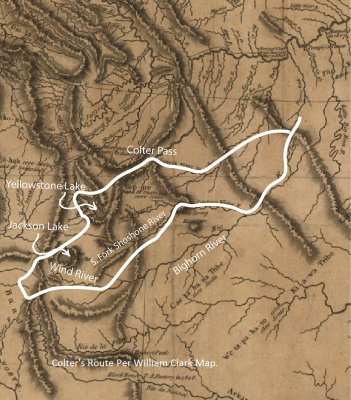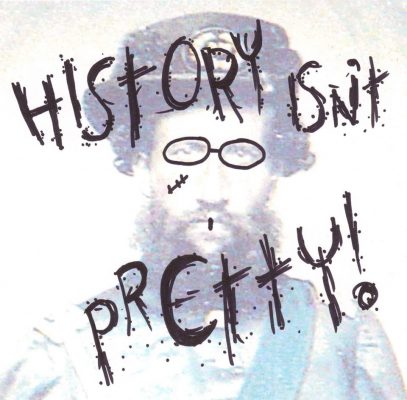This program features stories from the history of Bozeman and the surrounding area, presented or sponsored by the Extreme History Project.
-
The North Coast Limited, the Nightcrawler, and the Skidoo
Recently for the Extreme History Project, Professor Dale Martin from the History Department at Montana State University described the state of public transportation in Montana 100 years ago, when dozens of daily passenger trains reached almost every county in the state, carrying people, express, U.S. Mail, cans of milk, and money. His talk, entitled “The North Coast Limited, the Nightcrawler, and the Skidoo: A century of passenger trains and public transportation in Montana,” provides an overview and explanation of the many decades long decline of rail service, and intercity public transportation in general, since that time. Sponsored by the railroad enthusiasts of Montana Ntrak.
Recorded at the Museum of the Rockies on February 20, 2020.
or Download -
Understanding the Intricacies of Identity and the Power of Imagery
Apsaalooke/Tsistsistas (Crow/Northern Cheyenne) artist Ben Pease stands firmly upon the ideal of education via creativity as a contemporary storyteller. Pease’s work is well known for its unique and culturally relevant style using historic photographic references while also addressing current events and issues. In the contemporary art world, indigenous artists often confront issues like cultural appropriation, exotification, racism and stereotype disguised as appreciation and oblivion. In this talk, Pease touches on these issues through stories and learnings from his own life. Following the talk, with suggestions from the audience, Pease painted over a previously created painting of Christopher Columbus, using red paint, the same color as a statue on which audience members were asked to write words that came to mind when thinking of Indians.
Recorded at the Museum of the Rockies on October 24, 2019.
or Download -
Symbolism in the Cemetery
Cemeteries are like outdoor museums, full of beauty, history, and symbolism. If we look closely, the art engraved on the historic headstones can give us clues to the past. In this lecture, Crystal Alegria, one of the founders of The Extreme History Project, leads us through the symbolism engraved on some of the headstones of Bozeman’s historic Sunset Hills Cemetery. She de-codes the symbolism, telling complex and fascinating stories of our town founders buried below.
Recorded at the Museum of the Rockies on September 19, 2019.
or Download -
National Park Architecture and Fred Willson
Bozeman’s best-known architect Fred Willson (1877-1956) believed that “architecture was a form of public service; to make the things of daily life beautiful.” During his career, he did just that. His architectural vocabulary stretched from Art Deco, to Mediterranean revival, and to National Park Rustic Architecture – which became known simply as ‘Parkitecture.’ This unique architectural style, perhaps for the first time in the history of American architecture, became an accessory to nature. This presentation by Richard Brown explores the origin of Parkitecture and Fred Willson’s involvement in it.
Recorded on February 21, 2019 at the Museum of the Rockies.
or Download -
Superfunded: Recreating Nature in a Postindustrial West
The EPA Superfund program was established in 1980 and over 1,700 locations have been placed on the National Priorities List. Superfund sites cover a vast array of environmental damages that contaminate the land and impact the health of citizens across the nation. There are 17 Superfund sites in Montana, including even a small one in Bozeman. In this presentation, Jennifer Dunn, a doctoral candidate in history at MSU, traces the development of the Superfund and focuses on the different historical and current situations in Butte and Libby. She is introduced by Crystal Alegria, director of the Extreme History Project.
Recorded at the Museum of the Rockies on November 15, 2018.
or Download -
Warm Springs are for Healing: Montana’s Psychiatric Hospital
Since its establishment in 1875, the campus at Warm Springs, now called the Montana State Hospital, has been put to use towards the palliative treatment of Montanans. The supervisors transformed what had been a health resort into a hospital dedicated to the care of the “mentally deficient wards” of the state. The changes to the campus and its buildings reflect the changing trends in mental health care over the years. Warm Springs was more comprehensive in that it also was self-sufficient for much of its history, with manufacturing and farming considered part of the care for the patients. In this talk for the Extreme History Project, Architect Lesley Gilmore tells about this history and some of the personal stories within it.
Recorded at the Museum of the Rockies on October 11, 2018.
or Download -
Becoming Chinese in Montana
That Montana had a large Chinese population in the late-19th century is well known. However, most analysis of this community focuses solely on their challenges and contributions in the American West, paying little attention to the transnational nature of the Chinese experience. Mark Johnson, University of Notre Dame, helps us understand Montana’s Chinese pioneers through a global lens. They are seen as active and engaged participants who used the skills gained through their time in the American West to work for self-improvement and to strengthen a severely weakened China they had temporarily left but never forgotten.
Recorded August 17, 2017 at the Museum of the Rockies.
or Download -
Helen McAuslan, Modern Medium: Art and Architecture in Twentieth-Century Bozeman
This presentation by Will Wright focuses on the life and home of abstract painter Helen McAuslan, using both to understand the connections between art and architecture within the context of Montana’s modernist movement. A common thread for McAuslan’s version of “modernism” was her rejection of a traditional past in hope for a more liberated future. McCauslan’s concern with social justice, reflected in her Kent State paintings, also developed into political engagement through the League of Women Voters. If the nineteenth-century West was remembered through the works of male artists such as Charles Russell and Frederic Remington, then the twentieth-century West should be known through the contributions of female artists like McAuslan.
Recorded August 30, 2017 at the Museum of the Rockies.
or Download -
MT Pioneer Jews
In this Extreme History event from July 26, 2018 at the Hager Auditorium of the Museum of the Rockies, historian, author and educator, Dr. Ellen Baumler, discusses her research on Montana’s Pioneer Jewish Communities. How early in Montana’s history did Jews arrive? When, and in what ways, did they become influential? What were the differences among the Jews who settled in Helena, Bozeman, Butte, and Billings? Why was Helena’s YWCA the only unaffiliated chapter in the entire United States until the 1980s? Dr. Baumler reveals answers to these and many other questions.
or Download -
Hazel Hunkins of Billings: Protesting at the White House, 1917–19
Western Heritage Center Director Kevin Kooistra tells the story of Billings native Hazel Hunkins. Denied the opportunity to work in a local chemistry lab because of her gender, Hunkins promptly joined the national fight for women’s suffrage. This gritty woman remained undeterred even after national resentment led to arrest and recrimination for Hunkins and her fellow protestors. Kooistra’s talk mentions 1908 views on immigration, the group “Women Opposed to Suffrage,” and the means by which Hunkins lit a fire on the grounds of the White House.
or Download -
Exploring the Crossroads of Heritage and Highway Maps
In the American West, history, myth, and landscape are bound together in the formation of a geographical imagination, producing place identities that are deeply entrenched. Place identity is intimately linked to awareness of the past and the construction of heritage. Heritage is constructed and inscribed into place identity via the production of cultural texts, including landscape, literature, popular media, and promotional materials, and, significantly, highway maps.
In this presentation, Rob Briwa introduces the key geographic concepts of place identity, heritage, and critical cartography by examining Montana’s Highway Commission and its Department of Transportation and how it contributes to Montana’s heritage through its highway map program.
Slides from the presentation can be downloaded here (PDF). (more…)
or Download -
Race and Ruination: The Exodus of Montana’s African American Community
In 1910, Montana’s African American population constituted a vibrant community—seemingly on the precipice of growth and prosperity. By 1920, however, that growth faltered and the signs of decline were evident. Over the next decade, the population of the black community atrophied to nearly half its numbers from 1910, never again to recover. In researching numerous family and individual histories over the last three years, a key point of ambiguity in many African American narratives centers on why they left Montana. Leading up to the tumultuous social, economic, and environmental conditions that gripped the state starting in the late 1910s, new and unique western structures of racism were already in place. Consequently, this produced disproportionate hardships and bleak conditions for the black community.
This lecture by Anthony Wood will explore the history of black Montanans and their experiences in the early twentieth century. Through stories about the rise and fall of black night clubs in Helena, Buffalo Soldiers, homesteaders, unions, and other narratives in Montana’s history, we will come to a better understanding of the historical experiences of our fellow Montanans, and why so many chose to leave.
or Download -
What Secrets do 100+ Year-Old Apple Trees Hold?
Montana has a rich history of growing fruit including apples, pears, apricots, plums and cherries. Historically, orchards were planted throughout Montana by orchardists and homesteaders just trying to make a living. Although the orchardists and homesteaders may be gone, many of those orchards may still be intact today. Toby Day describes those heritage orchards, the ongoing research there, and how Montana State University Extension is working across the state to identify and preserve such orchards that still exist.
You can learn more about the Heritage Orchard Program from this MSU Extension document (PDF).
Recorded on September 21 at the Museum of the Rockies.
or Download -
Cultural Geography of Medicine Wheel Country
-
Recovering History: Salvage Archaeology at Fort Ellis
-
John Colter: Hunter, Trapper, Long Distance Runner

Colter in Yellowstone map. View in detail.
John Colter craved adventure, and when he signed on with the Lewis and Clark Expedition for five dollars a month, he got his fair share of it – and then some. Colter is best known for his infamous run from Blackfeet Indians near the Three Forks in 1808, but his role with the Corps of Discovery, the northwest fur trade, and early explorations of what is now Yellowstone National Park are just as important. Local broadcaster/historian John Russell will give an overview of Colter’s exciting, albeit brief life. (more…)
or Download -
The Last Will and Testament of Lizzie Williams: An African American Entrepreneur in 1870s Bozeman
With the end of the Civil War in 1865, African Americans joined the westward migration, hoping for a better life and opportunity in the West. We will explore the life of Lizzie Williams, An African American business woman who sought refuge in Bozeman during the 1870s. We will explore historic documents, including Lizzie’s last Will and Testament to better understand her life and catch a rare glimpse of early Bozeman through the lens of this African American woman. (more…)
or Download -
Building Community Through Historic Preservation
In this talk, Janet Ore, professor in the Department of History and Philosophy at Montana State University, discusses the concept of historic preservation and its application to Bozeman. Historic preservation arose as a movement to protect built environments that provided the tangible expressions of identity. Americans realized that in times of rapid change, places invested with history, memory, and emotion gave them a sense of history that could be lost when the physical markers of the past were eradicated. For many today, their multi-centered lives have impelled them to seek places where the symbols of a more rooted, seemingly less complex, past remain. Bozeman now stands at this juxtaposition.
Recorded at Museum of the Rockies on September 12, 2016.
or Download
